Ujjain Mahakal Mandir
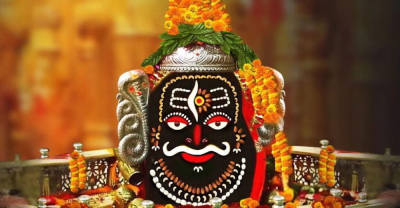
Nestled on the banks of the holy Kshipra River in the heart of Madhya Pradesh, lies the city of Ujjain. Its ancient streets hold a wealth of spiritual and cultural legacy. At its core is the Ujjain Mahakal Mandir, a venerable temple devoted to Lord Shiva - one of Hinduism's most prominent deities. The Mahakal Mandir serves as the pulsating center of Ujjain's spiritual fabric, embodying profound devotion, steadfastness, and unwavering faith.
Brief overview of Ujjain city
Ujjain, renowned as Ujjayini in ancient literature, boasts an ancestry that spans countless centuries. Its heritage intertwines with the very essence of Indian mythology and chronicles. Admired as one of the seven sanctified cities in Hindu culture, Ujjain maintains a cherished significance among millions of devout followers globally. Ujjain has served as a beacon of enlightenment throughout the ages, from its first mention in the sacred Vedas to its illustrious role as an esteemed hub of education and spiritual enlightenment during both the Maurya and Gupta dynasties.
Importance of Ujjain Mahakal Mandir in Hinduism
Atop Ujjain's scenic backdrop, the Mahakal Mandir reigns supreme in both physical stature and symbolic significance. Honoring Lord Shiva as the imposing embodiment of Mahakal, the Great Time, this hallowed sanctuary attracts devout pilgrims from across the world. The deity enshrined within is said to be swayambhu, self-made, imbued with celestial power that permeates the entire universe. The Mahakal Mandir holds a crucial place in Hindu cosmology, serving as a powerful representation of the timeless process of creation, sustenance, and dissolution.
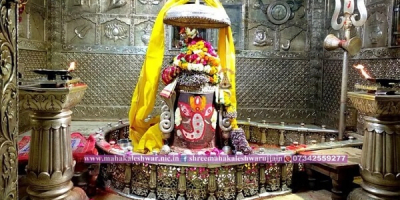
Purpose and structure of the blog
Embarking on a voyage through the enigma that surrounds the Ujjain Mahakal Mandir, our blog delves into its rich heritage, intricate design, profound spiritual value, and enduring influence. As we journey through the holy grounds of this sanctum sanctorum, we unveil the tales, customs, and divine revelations that have enthralled believers for ages.
Historical Background
Origins of Ujjain Mahakal Mandir
The origins of the Ujjain Mahakal Mandir are shrouded in the mists of time, intertwined with the mythical narratives that weave through the annals of Hindu lore. Legend has it that the temple traces its genesis to the primordial ages, when the gods and demons churned the ocean of milk in pursuit of the elixir of immortality, known as amrita. Amidst this cosmic upheaval emerged the poison, halahala, threatening to engulf the universe in its toxic embrace. In a desperate bid to save creation, Lord Shiva, the supreme deity, consumed the lethal brew and held it in his throat, earning him the epithet Neelkanth, the blue-throated one.
The site where drops of the divine poison are said to have fallen became hallowed ground, sanctified by the presence of the Mahakal Lingam, an embodiment of Shiva's cosmic power. Over the centuries, this sacred precinct evolved into the Ujjain Mahakal Mandir, a sanctum where pilgrims converge to pay homage to the eternal lord of time and transformation.
Evolution of the Temple Through Different Periods
Throughout its existence, the Ujjain Mahakal Mandir has witnessed the rise and fall of powerful dynasties, leaving their mark on the temple's structure and spiritual significance. From ancient manuscripts to the reigns of the Guptas and Paramaras, the temple has remained a center of worship for Lord Shiva, attracting devotees from far and wide.
However, the temple also faced periods of neglect and desecration throughout history. During the medieval era, invaders sought to seize its riches and defile its sacred grounds. Despite these challenges, devoted worshippers remained steadfast in their faith, ensuring that the flame of devotion continued to burn.
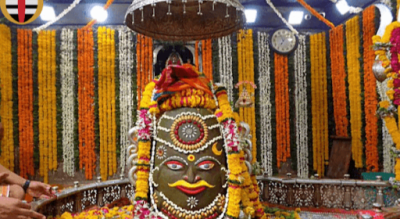
Architecture and Design
Description of the Temple Layout
The Ujjain Mahakal Mandir stands as a testament to the architectural prowess of ancient India, blending elements of Dravidian and Nagara styles to create a harmonious synthesis of form and function. The temple complex comprises several distinct structures, each dedicated to different aspects of the divine. At its heart lies the garbhagriha, housing the sacred Mahakal Lingam, where devotees offer prayers and seek blessings from the lord of time.
Surrounding the main shrine are a series of smaller temples and pavilions, each adorned with intricate carvings and sculptures depicting scenes from Hindu mythology. The outer walls of the temple are adorned with ornate motifs and friezes, depicting celestial beings and divine guardians, while the towering spire, or shikhara, reaches skyward, symbolizing the ascent of the soul towards enlightenment.
Architectural Style and Features
The architectural style of the Ujjain Mahakal Mandir reflects the cultural heritage of the region, with influences ranging from the ancient Mauryan period to the medieval Rajput kingdoms. The temple's distinctive features include its towering entrance gateways, known as gopurams, which are adorned with elaborate carvings and sculptures depicting gods, goddesses, and mythical creatures.
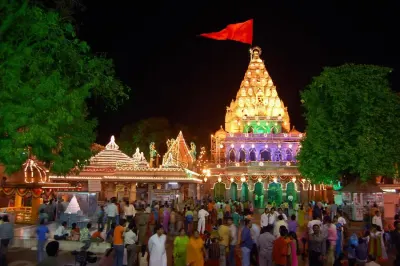
The interior of the temple is equally impressive, with intricately carved pillars, domed ceilings, and ornate altars dedicated to various deities. The garbhagriha, where the Mahakal Lingam is enshrined, is the focal point of the temple complex, drawing devotees into its sacred embrace with its aura of divine power and presence.
Symbolism Behind the Temple's Design Elements
Every aspect of the Ujjain Mahakal Mandir is imbued with symbolic meaning, reflecting the profound spiritual insights of Hindu cosmology. The temple's towering spire represents Mount Meru, the mythical abode of the gods, while its four cardinal directions symbolize the cyclical nature of existence.
The sacred waters of the Kshipra River, which flows beside the temple, are believed to purify the soul and grant liberation from the cycle of birth and death. Similarly, the ritual of circumambulating the temple in a clockwise direction, known as pradakshina, is thought to align the devotee's consciousness with the divine cosmic order.
Overall, the architecture and design of the Ujjain Mahakal Mandir serve as a testament to the timeless wisdom of Hindu spirituality, inviting devotees to embark on a journey of self-discovery and transcendence within its sacred precincts.
Religious Significance
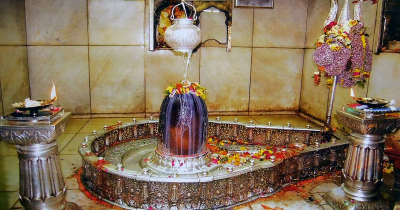
Worship Practices at Ujjain Mahakal Mandir
The Ujjain Mahakal Mandir serves as a focal point for devout Hindus seeking to connect with the divine essence of Lord Shiva. Worship at the temple follows a prescribed set of rituals and offerings, guided by ancient scriptures and tradition. Devotees typically begin their visit to the temple by performing abhishekam, the ceremonial bathing of the Mahakal Lingam with sacred substances such as milk, honey, and water. This act of devotion is believed to invoke the blessings of Lord Shiva and purify the soul of the worshiper.
Throughout the day, the temple resounds with the melodious chants of Vedic hymns and prayers, offered by priests and pilgrims alike. Special pujas and aartis are performed at regular intervals, inviting devotees to participate in the collective worship of the divine. The atmosphere within the temple is charged with spiritual energy, as devotees offer their prayers and seek solace in the presence of the eternal lord of time.
Festivals and Rituals Celebrated at the Temple
The Ujjain Mahakal Temple is famous for its many colorful festivals and ceremonies, bringing together a large number of worshippers from all parts of India. The temple's most sacred event is the celebration of Mahashivratri, a festival that honors Lord Shiva. In this holy ceremony, the temple is decorated with many flowers, shining lights and smells from incense sticks while believers come together to pray and ask for grace from the Mahakal Lingam.
Other significant celebrations at the temple are Shravan Maas, Navratri, and Kartik Purnima. Each has its own special ceremonies and practices. When these festivals happen, the temple fills with music for prayers, dances, and joy as people gather to pay respect to their god and strengthen their belief.
Spiritual Importance
Role of Ujjain Mahakal Mandir in Spiritual Practices
The Ujjain Mahakal Mandir holds a special place in the hearts of spiritual seekers, offering a sacred space for meditation, introspection, and inner transformation. The serene ambiance of the temple, coupled with its ancient vibrations of devotion, provides an ideal environment for seekers to commune with the divine presence of Lord Shiva. Many visitors to the temple embark on spiritual pilgrimages, seeking guidance, healing, and enlightenment from the cosmic energies that permeate its sacred precincts.
Pilgrimage Significance for Devotees
For millions of devotees worldwide, a pilgrimage to the Ujjain Mahakal Mandir is a sacred journey of self-discovery and spiritual renewal. The act of undertaking a pilgrimage, known as tirtha yatra, is believed to purify the soul and bestow blessings upon the devotee. It is said that those who visit the temple with a pure heart and sincere devotion are granted the opportunity to transcend the limitations of the material world and experience a deeper connection with the divine.
The pilgrimage experience at the Ujjain Mahakal Mandir is imbued with a sense of reverence and awe, as devotees immerse themselves in the timeless rituals and traditions that have been passed down through generations. From the moment they set foot in the sacred precincts of the temple, pilgrims are enveloped in a spiritual aura that uplifts the soul and awakens the innermost depths of their being.
Impact of the Temple on Local Culture and Community
The Ujjain Mahakal Mandir exerts a profound influence on the local culture and community, serving as a focal point for social, religious, and cultural activities. The temple plays a central role in the life of the city, serving as a gathering place for festivals, ceremonies, and religious gatherings. Its annual calendar of events brings together people from all walks of life, fostering a sense of unity and solidarity among the diverse communities that call Ujjain home.
Moreover, the temple serves as a hub of charitable activities, providing food, shelter, and support to those in need. Its philanthropic endeavors extend beyond the boundaries of religion, reaching out to the marginalized and vulnerable members of society. Through its various outreach programs and initiatives, the Ujjain Mahakal Mandir exemplifies the timeless values of compassion, service, and generosity that lie at the heart of Hindu spirituality.
Overall, the temple's impact on local culture and community underscores its enduring significance as a beacon of hope, inspiration, and divine grace in the modern world.

Cultural Influence
Influence of Ujjain Mahakal Mandir on Art and Literature
The Ujjain Mahakal Mandir has long been a source of inspiration for artists, poets, and scholars, who have sought to capture the essence of its spiritual beauty through their creative endeavors. Throughout history, the temple has been depicted in paintings, sculptures, and literary works, serving as a symbol of devotion and reverence for Lord Shiva. Its majestic architecture, vibrant rituals, and timeless teachings have inspired generations of artists to explore themes of divinity, transcendence, and the eternal mysteries of existence.
The temple's influence extends beyond the realm of art to encompass literature, music, and dance, where its sacred stories and teachings are celebrated through various artistic mediums. Poets and writers have penned verses and hymns in praise of the Mahakal Lingam, extolling its virtues and significance in the pantheon of Hindu deities. Likewise, musicians and dancers have incorporated themes from the temple's rituals and festivals into their performances, creating a vibrant tapestry of cultural expression that reflects the rich heritage of Ujjain and its sacred temple.
Impact on Regional Festivals and Traditions
The Ujjain Mahakal Mandir exerts a profound influence on the regional festivals and traditions of Ujjain, shaping the cultural identity of the city and its inhabitants. The temple's annual calendar of events, which includes festivals such as Mahashivratri, Shravan Maas, and Navratri, serves as a focal point for community celebrations and religious observances. These festivals bring together people from all walks of life, transcending barriers of caste, creed, and social status to foster a sense of unity and solidarity among the diverse communities of Ujjain.
Moreover, the temple's influence extends beyond the confines of its sacred precincts to permeate every aspect of daily life in Ujjain. From the colorful processions and street performances that accompany religious festivals to the traditional rituals and customs observed by families in their homes, the temple's presence is felt in every corner of the city. Its teachings and values serve as a guiding light for the people of Ujjain, inspiring them to lead lives of virtue, compassion, and devotion to the divine.
In essence, the Ujjain Mahakal Mandir serves as a custodian of the cultural heritage of Ujjain, preserving ancient traditions and teachings for future generations to cherish and uphold. Its influence on regional festivals and traditions underscores its enduring significance as a symbol of faith, unity, and cultural pride in the vibrant tapestry of Indian civilization.
Visitor Experience
Description of the Pilgrimage Journey to Ujjain Mahakal Mandir
For pilgrims embarking on a journey to the Ujjain Mahakal Mandir, the experience is more than just a physical voyage—it is a spiritual odyssey of self-discovery and divine communion. The pilgrimage begins long before devotees set foot in the sacred precincts of the temple, with preparations that involve purification rituals, fasting, and prayers to Lord Shiva. As the journey unfolds, pilgrims traverse the ancient streets of Ujjain, steeped in history and legend, en route to the hallowed grounds of the Mahakal Mandir.
Upon arrival at the temple, pilgrims are greeted by the majestic sight of the towering spire and ornate entrance gateways, signaling their entry into a realm of sacredness and sanctity. The air is filled with the fragrance of incense and the sound of devotional chants, creating an atmosphere of serenity and reverence that envelops the devotee's soul. With each step taken towards the garbhagriha, pilgrims feel a deepening sense of connection to the divine presence of Lord Shiva, whose blessings they seek to invoke through their prayers and offerings.
Facilities and Amenities for Visitors
The Ujjain Mahakal Mandir strives to provide pilgrims with all the necessary facilities and amenities to ensure a comfortable and fulfilling pilgrimage experience. The temple complex is equipped with clean restrooms, drinking water facilities, and designated areas for meditation and reflection. Additionally, the temple authorities offer a range of services, including guided tours, accommodation arrangements, and medical assistance, to cater to the needs of visitors from diverse backgrounds.
For those seeking a deeper immersion in the spiritual atmosphere of the temple, various seva and darshan packages are available, allowing devotees to participate in special rituals and ceremonies conducted by the temple priests. Moreover, the temple premises are wheelchair accessible, ensuring that people with disabilities can also partake in the sacredness of the Mahakal Mandir without hindrance.
Overall, the Ujjain Mahakal Mandir strives to create an inclusive and welcoming environment for all visitors, regardless of their background or beliefs. By providing essential facilities and services, the temple aims to enhance the pilgrim experience and facilitate a deeper connection between devotees and the divine presence of Lord Shiva.
Preservation Efforts and Challenges

Conservation Efforts for Ujjain Mahakal Mandir
Preserving the cultural and historical significance of the Ujjain Mahakal Mandir is a paramount concern for both the local community and heritage conservation authorities. Over the years, various initiatives have been undertaken to safeguard the temple's architectural integrity, protect its sacred artifacts, and promote awareness of its cultural heritage. These efforts encompass a range of activities, including structural repairs, documentation of heritage assets, and implementation of sustainable conservation practices.
One notable conservation project is the restoration of the temple's ancient stone carvings and sculptures, which have been subjected to weathering and erosion over centuries of exposure to the elements. Skilled craftsmen and conservation experts work tirelessly to repair damaged carvings, clean accumulated debris, and apply protective coatings to prevent further deterioration. Additionally, efforts are underway to digitize archival records and historical documents related to the temple, ensuring that valuable information about its heritage is preserved for future generations.
Challenges Faced in Maintaining the Temple's Heritage
Despite ongoing conservation efforts, the Ujjain Mahakal Mandir faces several challenges in maintaining its rich cultural heritage. Chief among these challenges is the threat posed by urbanization and encroachment, as rapid development in the surrounding area puts pressure on the temple's historic precincts. Unregulated construction, traffic congestion, and pollution have the potential to disrupt the temple's sacred atmosphere and compromise its architectural integrity.
Furthermore, the temple is vulnerable to natural disasters such as floods, earthquakes, and cyclones, which pose a significant risk to its structural stability and safety. Efforts to mitigate these risks involve implementing disaster preparedness plans, reinforcing vulnerable structures, and conducting regular inspections to identify potential hazards.
Another challenge is the need to balance conservation with the demands of modernization and tourism. As the popularity of the Ujjain Mahakal Mandir grows, so too does the influx of visitors seeking to experience its spiritual aura and cultural heritage. While tourism can generate much-needed revenue for the temple and the local economy, it also brings with it the risk of overdevelopment, environmental degradation, and damage to heritage sites.
In response to these challenges, stakeholders are working collaboratively to develop sustainable tourism strategies, promote responsible visitor behavior, and raise awareness about the importance of preserving the temple's cultural heritage. By fostering a sense of ownership and stewardship among the local community and visitors alike, it is hoped that the Ujjain Mahakal Mandir will continue to thrive as a living testament to India's ancient heritage for generations to come.
Conclusion
The Ujjain Mahakal Mandir is an emblem of devoutness, persistence, and cultural opulence in the core of India. The temple epitomizes the divine essence of Hinduism and serves as a guiding light for worshippers worldwide. Through its architecture, rituals, and teachings, the Mahakal Mandir invites pilgrims to embark on a journey of self-discovery and communion with Lord Shiva.
As stewards of this sacred heritage, we have a joint duty to preserve the sanctity of the Ujjain Mahakal Mandir. This involves maintaining its structural integrity, protecting its revered relics, and promoting awareness of its cultural significance. By doing so, we ensure that future generations can cherish and uphold the temple's legacy, allowing its spiritual radiance to guide seekers for years to come.




